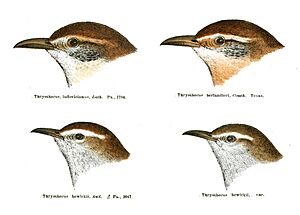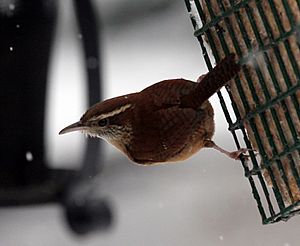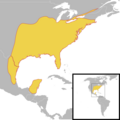Carolina wren facts for kids
Quick facts for kids Carolina wren |
|
|---|---|
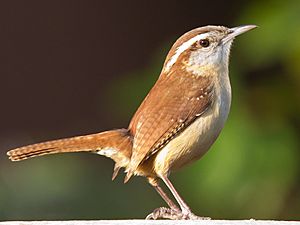 |
|
| Conservation status | |
| Scientific classification | |
| Genus: |
Thryothorus
|
| Species: |
ludovicianus
|
| Subspecies | |
|
List
T. l. berlandieri
T. l. burleighi T. l. lomitensis T. l. ludovicianus T. l. miamensis T. l. nesophilus T. l. tropicalis T. (l.) albinucha – White-browed wren |
|
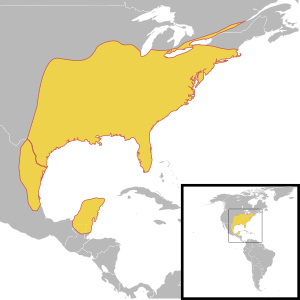 |
|
| Range of the Carolina wren (T. ludovicianus) | |
| Synonyms | |
|
Sylvia ludoviciana (Latham, 1790) |
|
The Carolina wren (Thryothorus ludovicianus) is a common bird. It lives in the eastern United States, southern Ontario, Canada, and northeastern Mexico. Very cold winters stop them from moving too far north. But good weather helps them spread their homes further. They like to live in thick forests, near farms, and in suburban gardens. This wren is the state bird of South Carolina.
There are seven types of Carolina wrens. They look and sound a little different. These birds usually stay hidden and do not like open spaces. When they are out, they move around a lot and are rarely still. Once a male and female find each other, they stay together for many years. They also protect their home area. Both male and female wrens make alarm calls. But only the males sing to show off their territory. Carolina wrens can have many babies during the summer. Sometimes, other birds like brown-headed cowbirds lay their eggs in the wren's nest. This is called brood parasitism. Some wren groups have also been affected by mercury pollution.
Contents
What is the Carolina Wren's Family Tree?
The Carolina wren was first named Sylvia ludoviciana by John Latham in 1790. Later, Louis Jean Pierre Vieillot put it in its own group, Thryothorus, in 1816. The name Thryothorus comes from Greek words meaning 'reed jumper'. The name ludovicianus is Latin and means 'from Louisiana'. This is where the first bird was found.
Long ago, the Thryothorus group had many species. But scientists used DNA studies to learn more. They found that the Carolina wren is now the only species in this group.
There are seven types (subspecies) of the Carolina wren:
- T. l. ludovicianus: Found in southeastern Canada and the eastern United States.
- T. l. miamensis (Florida wren): Lives in Florida.
- T. l. nesophilus: Found on Dog Island in Florida.
- T. l. burleighi (Burleigh's Carolina wren): Lives on islands off the Mississippi coast.
- T. l. lomitensis (Lomita wren): Found from southern Texas to northeastern Mexico.
- T. l. berlandieri (Berlandier's wren): Lives in northeastern Mexico.
- T. l. tropicalis: Found in northeastern Mexico.
Some scientists think the Carolina wren is closely related to the Bewick's wren. There is also a group of wrens in Mexico and Central America. Some people call it Cabot's wren or white-browed wren (Thryothorus albinucha). Some think it is a separate species, while others see it as a type of Carolina wren.
What Does a Carolina Wren Look Like?
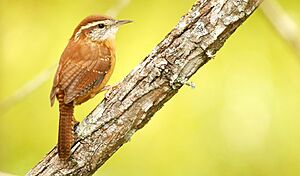
The Carolina wren is a fairly large wren. It is about 12.5 to 14 centimeters (5 to 5.5 inches) long. Its wingspan is about 29 centimeters (11.4 inches). It weighs about 18 to 23 grams (0.6 to 0.8 ounces). It is the second largest wren in the United States. Only the cactus wren is bigger.
Male wrens are usually a bit bigger than females. One study found that almost all males were larger than their female partners. Males were about 11% heavier and had longer wings.
Different types of Carolina wrens have small differences in their looks.
- The main type, T. l. ludovicianus, has a rich brown head. Its back and tail feathers are more chestnut-colored. Its shoulders are rich brown. It has small white dots on some wing feathers. Its tail feathers are brown with dark bars.
- It has a white stripe above its eye, with thin black lines around it. This stripe goes past its shoulders. Its chin and throat are gray. Its chest, sides, and belly are buff-colored. Its eyes are reddish-brown. Its beak is lemon-colored and paler at the bottom. Its legs are flesh-colored.
Other types of wrens have slight differences:
- T. l. berlandieri is a bit smaller but has a bigger beak. Its upper parts are duller brown.
- T. l. lomitensis is duller in color. Its underparts are pale or almost white.
- T. l. miamensis has darker, rusty brown upper parts.
- T. l. burleighi is duller and sootier. Its tail markings are less clear.
- T. l. nesophilus has paler underparts and a whiter stripe above its eye.
- T. l. tropicalis is darker than all other types.
Baby Wrens and Feather Changes
Baby Carolina wrens look similar to adults. But their feathers are paler and softer. They have buff-tipped wing feathers. The white stripe above their eye is less white.
In late summer, young wrens change some of their feathers. They become darker. Adult wrens also change their feathers around this time. Both male and female adults look similar after this change.
How Long Do Carolina Wrens Live?
How long wrens live depends on where they are. One male wren in Arkansas lived for at least 73 months (over 6 years). In Alabama, the oldest female was six years old, and the oldest male was ten years old. A study from 1992 to 2003 showed that about 90% of tagged wrens died within 10 years.
Birds That Look Like Carolina Wrens
The Bewick's wren is often confused with the Carolina wren. But the Bewick's wren is smaller. It has a longer tail and is grayer-brown on top and whiter underneath.
Carolina wrens and white-browed wrens are larger than the house wren. They also have a longer beak and a longer back toe.
Where Do Carolina Wrens Live?
These birds usually stay in one place. They only move further north after mild winters. After mild winters, Carolina wrens have sometimes bred as far north as Maine and Quebec. In places like Iowa, long periods of snow can stop them from spreading.
Their main breeding areas stretch from eastern Nebraska and southern Michigan to the New England states. They also live in Mexican states like Coahuila and Tamaulipas, and along the Gulf Coast of the United States. Sometimes, they are seen in places like Colorado and New Mexico.
The area where wrens live has grown northward and westward over the last few centuries. In Massachusetts, they spread west and northeast in about 35 years. In New York, their numbers tripled in about 25 years. In states like Ohio and Michigan, their numbers have grown since the 1800s. This spread might be because of fewer harsh winter storms. Also, there are more forests and wrens use urban areas with bird feeders, especially in winter.
Carolina wrens can live in many different places. They like forests with oak and pine trees. They also like areas with lots of tangled plants. They prefer forests near water, bushy areas, swamps, overgrown farmland, and suburban yards. They like places with many thick shrubs and trees, and parks. They also like old buildings and messy yards in towns. Some types of wrens live in slash pine and palmetto trees.
How Do Carolina Wrens Behave?
Songs and Calls
Carolina wrens sing all year round, any time of day. They usually do not sing during very bad weather. Only male wrens sing. They have many different song patterns, often around 32. They repeat one pattern for several minutes. A song can be repeated up to twelve times, but usually three to five times. When they sing, their tail points down.
Some common songs sound like teakettle-teakettle-teakettle or cheery-cheery-cheery. People also describe their songs as sweet heart, sweet heart or come to me, come to me.
Male wrens learn new songs when they are young. Because they stay in one place, they learn songs within their first three months of life. Even small water barriers can affect how many songs a male wren knows.
Female Carolina wrens can also make sounds. They sometimes make calls with the male. This suggests they understand the songs.
Different types of wrens have different songs. For example, the miamensis type sings faster and has more notes than wrens further north.
Their songs can sometimes sound like the Kentucky warbler. But the warbler's song is richer and faster. Other birds like the flicker, Baltimore oriole, and grey catbird also have calls that sound a bit like the wren's. Sometimes, wrens even copy other birds. In Pennsylvania, they are sometimes called 'mocking wrens' because of this.
Protecting Their Home
Both male and female wrens protect their home area. They can tell how close a threat is by how loud a bird's song is. If a song sounds unclear, wrens think the threat is far away and do not react. If the song is clear, they might attack.
Not all birds in their area are enemies. Wrens sometimes see neighboring birds as 'dear-enemies'. They react differently to neighbors and strangers depending on the season. In spring, they are more aggressive towards neighbors. But in fall, they treat neighbors and strangers the same. When protecting their nest, they usually make alarm calls. They also judge the size of a threat. For example, they avoid attacking a large blue jay to prevent injury.
Both males and females use calls when there is danger. Males make a cheer call. In southern areas, males make a ringing pink or p'dink sound. Females are the only ones that make dit-dit or chatter sounds. The dit-dit call is used in fights with predators. The chatter is used when another male bird sings in their territory.
What Do Carolina Wrens Eat?
Carolina wrens spend most of their time on the ground looking for food. They also search in tangled plants and vines. They look for food in tree bark or by flipping over leaves. Their diet is mostly invertebrates. These include beetles, true bugs, grasshoppers, katydids, spiders, ants, bees, and wasps. They also eat small lizards and tree frogs. A small part of their diet is plant matter, like fruit and seeds. In colder northern areas, they often visit bird feeders.
How Do Carolina Wrens Move?
Carolina wrens are shy. You are more likely to hear them than see them. On the ground, they move with quick hops. They search through things, whether natural or man-made. They pause to chatter or sing. When they are still, they twitch their bodies. They also like to sunbathe or sandbathe.
They can be skittish around humans. If they see someone coming, they slowly move into cover. But sometimes, they will come closer to humans if they stay still. They can also crawl like a creeper and hang upside down like a nuthatch.
Their flights are usually short, fast, and low to the ground. Their wings flap quickly. They often fly when looking for food. They can also fly straight up from the bottom of a tree to the top.
Raising a Family
Carolina wrens usually stay with the same mate for their whole lives. It is rare for them to change partners. During winter, males are better at guarding their home area. Females sometimes struggle to keep a territory without a mate in winter. Staying together helps them survive the winter, when many wrens die. It also helps them stay bonded.
Their nests are shaped like an arch with an opening on the side. They build them from dried plants or bark strips. They also use horsehair, string, wool, and even snake skin. Males gather materials, while females build the nest. Nests are found in holes in trees or in human-made places. These can be bird-boxes, buildings, tin cans, mailboxes, or even hanging jackets. Nests are usually 1 to 3 meters (3 to 10 feet) off the ground. They are rarely higher.
The number of eggs and when they are laid changes by region. In Texas, they lay eggs from late February to late August. In Iowa, it is from late April to June. They usually lay 3 to 6 eggs, but sometimes up to seven. The eggs are creamy white with brown or reddish-brown spots. The female sits on the eggs for 12–16 days. After the babies hatch, they eat only invertebrates. They leave the nest in 12–14 days. A pair can raise up to three groups of babies in one summer.
Both parents feed the babies. Males feed them slightly more when they are very young. Both parents feed the babies more as they get older.
Dangers and Threats to Carolina Wrens
Sometimes, brown-headed cowbirds lay their eggs in Carolina wren nests. This is called brood parasitism. In some areas, up to 25% of wren nests are affected. Cowbirds sometimes push out wren eggs before laying their own. Even if wren eggs stay, the larger cowbird eggs can stop wren eggs from hatching. This can greatly affect how many wren babies survive. Cowbird babies also eat more than wren babies. This can be bad for the wren babies.
Rarely, a house finch has also laid an egg in a wren nest. Brood parasitism is less common in natural, hidden nests. Other parasites, like blowflies, feed on baby wrens. The blood loss makes the babies weak. Other wren species, like the Bewick's wren, compete for nesting spots.
In Virginia, some Carolina wrens have high levels of mercury in their blood. They get this from eating spiders all year. Spiders eat other creatures, so they can have more mercury. Since wrens live in the same place all year, they are at higher risk. Nests were abandoned more often when mercury levels were high. Cold weather, ice, and snow can also harm wren babies and adults. Wrens that survive these winters find sheltered places.
Some animals that hunt adult Carolina wrens are domestic cats and snakes like the timber rattlesnake. Raccoons and black rat snakes also eat wren eggs and babies.
Carolina Wrens in Culture
In 1930, a women's club in South Carolina chose the Carolina wren as their unofficial state bird. They wanted it to be the official state bird. In 1939, the state chose the northern mockingbird instead. But in 1948, they changed their minds. The Carolina wren became the official state bird of South Carolina.
In 2000, the Carolina wren was shown on the back of the South Carolina state quarter.
Images for kids
See also
 In Spanish: Cucarachero de Carolina para niños
In Spanish: Cucarachero de Carolina para niños



